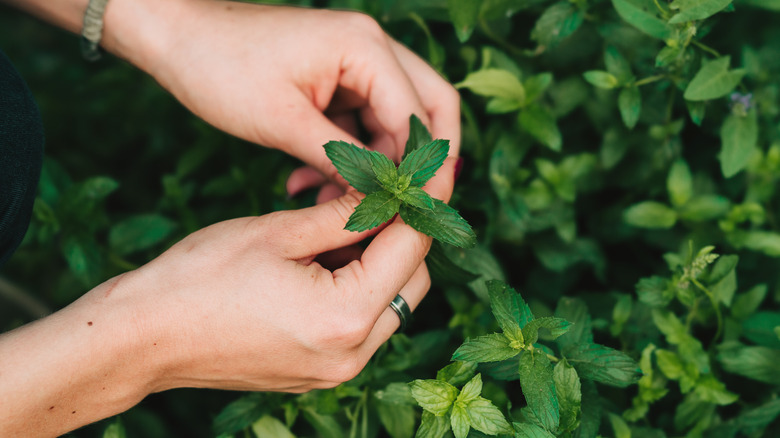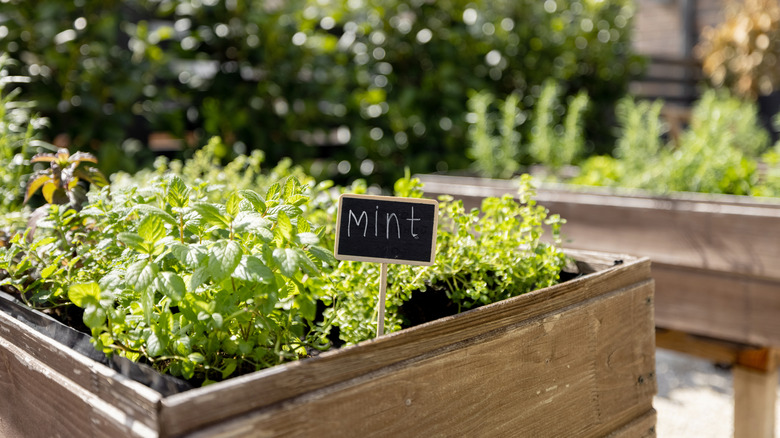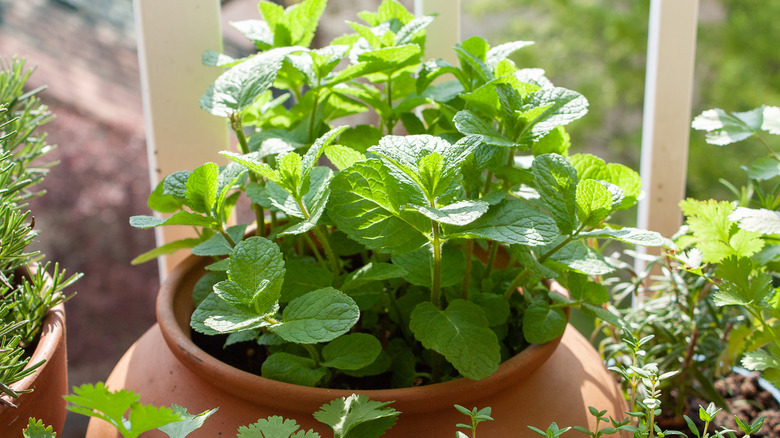The Clean-Smelling Herb That'll Help Manage Pests In The Garden
Finding that deer have munched away all of the tomato buds on your garden plants or an insect has decimated your growing romaine lettuce can be frustrating. Mint, one of the most fragrant of herbs, could be the answer to preventing this problem. The scent is so robust that many pests, including deer, flea beetles, and ants, are repelled by it. That scent is so significant that it works as a natural deterrent for many of the most common garden destroyers out there.
Mint isn't too challenging to grow if you give it the right conditions and monitor its development. It can be an aggressive grower, taking over large portions of the garden if you don't contain it. Consider placing it just outside the perimeter of the garden or in herb containers nearby to stop it from infiltrating the rest of the space. Not only will it help your garden to keep away the mosquitos and mites, but it may also create a wonderfully fresh, clean scent throughout your backyard. Even better, once it starts to flourish, you can trim some off to add to tea, salads or make a mint jelly on your own. Mint is one of the best, fast-growing herbs to add to your garden. Before you head off to purchase a few mint starter plants, there are a few things to consider and plan for first.
How to grow mint for pest control in your garden
Mint typically does well in Zones 3 to 11, though it does require the right conditions. Typically, it does best in part shade rather than full sun, but if you keep the soil moist during hot spells, it can tolerate direct sunlight well. The key to success with mint, though, is a nutrient-rich soil, one that has a slightly higher acidic level. It works well, then, as a companion plant to other herbs like parsley as well as most peppers, carrots, tomatoes, squash, and cucumbers, all of which appreciate a higher acidic level. Using a natural, organic fertilizer can help to improve soil conditions to reach this level.
If you already have pests infiltrating your garden, skip starting mint from seeds and purchase plants with several inches of growth already in place. Most types of mint work here, including peppermint, spearmint, and even chocolate mint (which could be a favorite for hot cocoa on a cold evening). Place individual plants at least 18 inches apart to ensure they have ample growing space, as they will fill in this area well.
Once in place, keep the soil moist for mint to thrive. It isn't likely to take long before you start to smell it, and that means the pests will, too.
How to use mint to get rid of pests in your garden
The menthol and pulegone in mint, which is what gives it that strong scent, is a deterrent to most pests, which means if they smell it, they are likely to look for another place for their next meal instead of your garden. Just monitor its growth.
As noted, mint grows quickly by spreading rapidly. If you don't have a lot of garden space, that's a concern. One solution is to plant the mint in areas where you know there are pests, or the deer have easy access to your vegetables. Doing this along the edge of the garden can help to protect what's within the space.
Yet another option is to plant mint into terra cotta pots, placing one plant in each. Then, nestle these into your garden in various areas. This allows the plant to benefit from the moisture and overall environment of the garden while working to deter pests.
If you really cannot dedicate any space to growing mint, consider placing a few sprigs of fresh mint from your kitchen windowsill garden around the outside of your garden or near the plants being chomped on. This is a short-term solution but may help you to protect those plants a bit longer.


